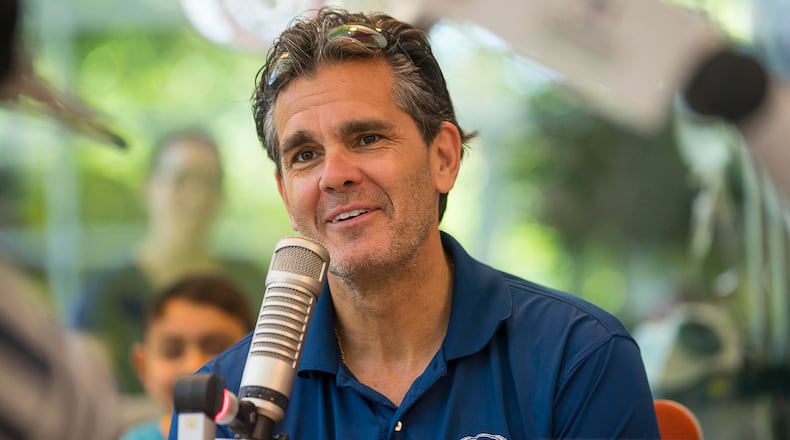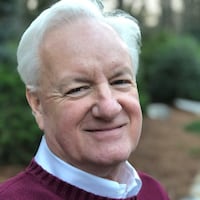When Fox Sports South televises the Braves’ season opener, announcers Chip Caray, Jeff Francoeur and Tom Glavine will call the game from 750 miles away.
They won’t be at New York’s Citi Field, site of the Braves’ opener July 24 against the Mets, as they typically would be. Instead, they will watch – and call – the action based on live camera feeds sent by the Mets’ network to the broadcast booth at Truist Park in Cobb County.
Not having the announcers at road games will be one of many changes on Braves telecasts when the pandemic-delayed season begins.
“It’s going to be really, really different. Obviously, that’s the understatement of the year,” said Jeff Genthner, general manager and senior vice president of Fox Sports South and Fox Sports Southeast, the two Atlanta-based regional sports networks scheduled to televise 55 of the Braves’ 60 regular-season games this year. “I think this is going to be a season that will be studied for years to come, to say the least.”
Changes on the telecasts will be impossible for viewers to miss. Instead of the normally ubiquitous camera shots of cheering fans, you’ll see empty seats. Instead of the normally bustling sound of ballparks, expect to hear fake crowd noise piped in to drown out eerie silence.
But probably the first thing you’ll notice if you watch the regular-season opener and the Braves’ other 29 road games is that the announcers — play-by-play voice Caray and analysts Francoeur and Glavine — aren’t on the scene. In-game reporters Kelly Crull and Paul Byrd also will work the road games from Truist Park.
Calling road games from teams’ home stadiums — or in some cases from a studio in the home market — will be standard practice around MLB this season as teams try to guard against COVID-19 by keeping the traveling parties on their chartered flights as small as possible and limiting the number of media members and other personnel in stadiums.
Radio broadcasters also won’t travel to road games this season. Jim Powell and Joe Simpson will call the Braves’ road games on radio by watching the same camera feeds the TV broadcasters will use, likely in their Truist Park radio booth or possibly in a 680 The Fan studio, according to the Braves.
On TV, the pregame and postgame shows will air from a studio in Midtown Atlanta, even for home games, because that was deemed safer than from a set in The Battery Atlanta.
Fox Sports South considered sending Crull to New York on a commercial flight for the opening series before deciding a few days ago that didn’t make sense.
“The challenge was that the Major League Baseball protocols in terms of access to stadiums are so tight that we could travel her, but not be sure we could get her in the building,” Genthner said. “And then once in the building, the access to getting anywhere close to coaches and players is going to be extremely restricted. So we made the decision we’re not traveling (Crull or Byrd) on the road.”
“It’s definitely going to be an evolution, not traveling,” Fox Sports South/Southeast executive producer Jamie Shapiro said. “But safety is important. Traveling reporters around the country on commercial flights right now is just not something that I think we’re comfortable with.”
For the Braves’ first two games, camera feeds will be provided by Mets broadcaster SportsNet New York (SNY) to Fox Sports South (FSSO). Rather than having a production crew on the road, as usual, FSSO will produce the telecasts from a truck at Truist Park. Graphics will be inserted there to make the presentation look familiar to Braves fans.
Although networks have long shared some cameras on baseball telecasts, Fox Sports South/Southeast will have far less control than usual over camera shots at road games this year, limited to one freelance camera operator that they can direct, plus the home team’s feed.
“This whole process has been really collaborative,” Shapiro said. “Every (regional sports network) throughout the country is operating under this model.”
The Braves’ TV announcers will call road games while watching the same video that viewers see, but also will have access to an additional monitor with a wider angle of the field. That reference tool will aid their call by enabling them to see the entire defense “as if they were at the ballpark seeing it with their own eyes,” Shapiro said. “It’s an adjustment, no question.”
On about half of the season’s 55 telecasts scheduled on Fox Sports South/Southeast, including the first two, a three-man tandem of Caray, Francoeur and Glavine will call the games, Shapiro said. On the rest, Caray and Francoeur will do so. Social distancing between broadcasters is under discussion.
“Do you put Plexiglas between them? Do you spread them across two booths so they may not be sitting right next to each other?” Genthner said. “We are exploring those options.”
While the Braves’ announcers will be at home games, they won’t have their normal access to players.
In the past, the in-game reporters often worked from positions adjacent to the Braves’ dugout. This season, newcomer Crull and returnee Byrd will work from the empty lower seating bowl at home games but won’t have face-to-face interviews with players. The plan is for them to go beyond Zoom press conferences by “using their contacts to get content they can share from any location on home or road telecasts,” Shapiro said.
The natural backdrop of broadcasts -- the sound of the crowd -- will be absent as games are played without fans in attendance. Teams plan to pipe in artificial crowd noise over stadium sound systems so that it’s audible on TV and radio.
MLB has provided teams about 75 different sound effects, ranging from a consistent murmur to a loud roar.
“At the very beginning, I wasn’t a fan of the idea,” Genthner said. “But if it creates kind of a buzz and also is inspiring for the players on the field, listen, we’d be foolish to summarily dismiss any creative idea in this season.”
The telecasts are even more important than usual to MLB, providing a huge portion of the abbreviated season’s much-diminished revenue. That could open some opportunities for the networks.
“Baseball has made it clear they’re going to be much more lenient with the production elements this year than ever before,” Genthner said, “and we are trying to figure out how we can take a game that is being played in an empty stadium and give fans a home viewing experience like they’ve never seen before.”
He and his staff are kicking around ideas such as having an umpire or a catcher wear a microphone during games or putting a small camera on the batting helmet of third-base coach Ron Washington.
“It’s going to be very fluid,” Genthner said. “We’re going to do the best we can to do things different.”
He expects a pent-up demand among viewers for Braves baseball when the season opens four months later than originally scheduled.
A telecast of a Braves intrasquad scrimmage, of all things, drew a 1.1 rating in the Atlanta TV market Monday night – “a monster number for an intrasquad game,” Genthner said. That rating means 1.1% of the households in the market, or about 25,000 homes, watched on average.
“I think that’s an early indication of the thirst that Braves fans have for this product to come back,” Genthner said.
Amid COVID-19, it’s going to be a season like no other.
“I think at the beginning of the season, the first games in New York and the first games at Truist, playing in front of no fans, it’s awkward, it’s different, you can’t hide it, and I think it’s important to acknowledge,” Genthner said. “But at the end of the day, the story is going to be the action on the field.
“We don’t want to put a cloud over that by constantly talking about COVID. We’re going to talk about it (some). People are going to understand it. Then let’s move on and talk about the game.”
About the Author
Keep Reading
The Latest
Featured



